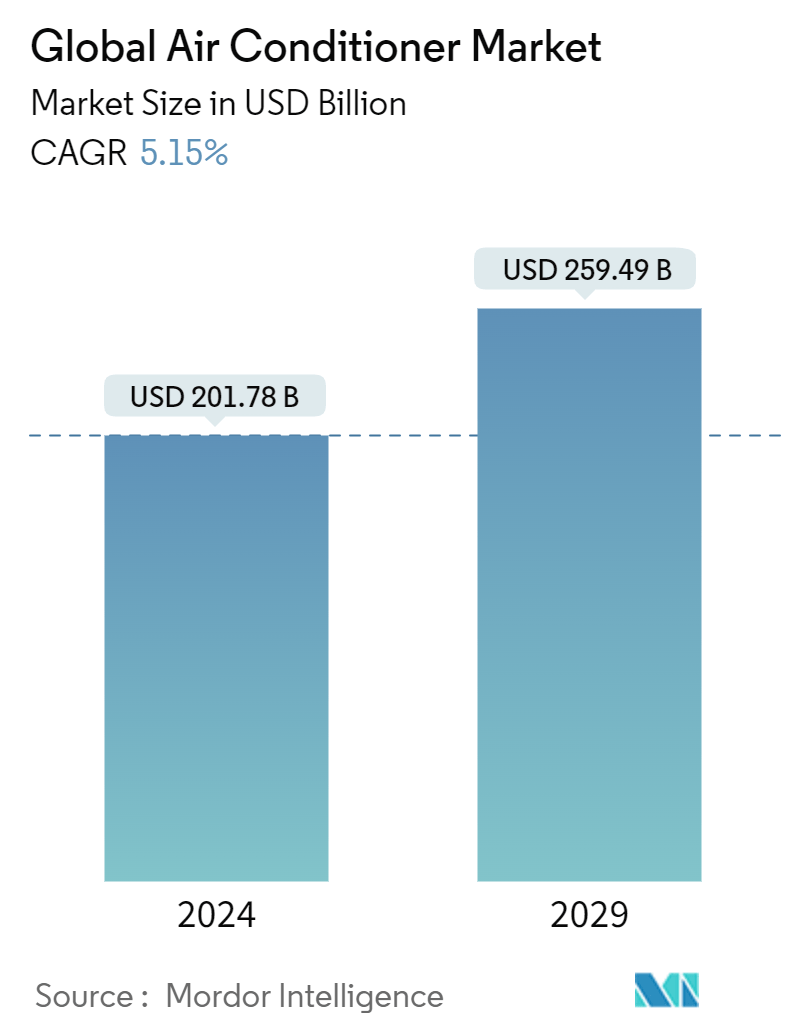
| Study Period | 2020 - 2029 |
| Market Size (2024) | USD 201.78 Billion |
| Market Size (2029) | USD 259.49 Billion |
| CAGR (2024 - 2029) | 5.15 % |
| Fastest Growing Market | North America |
| Largest Market | Asia Pacific |
| Market Concentration | Low |
Major Players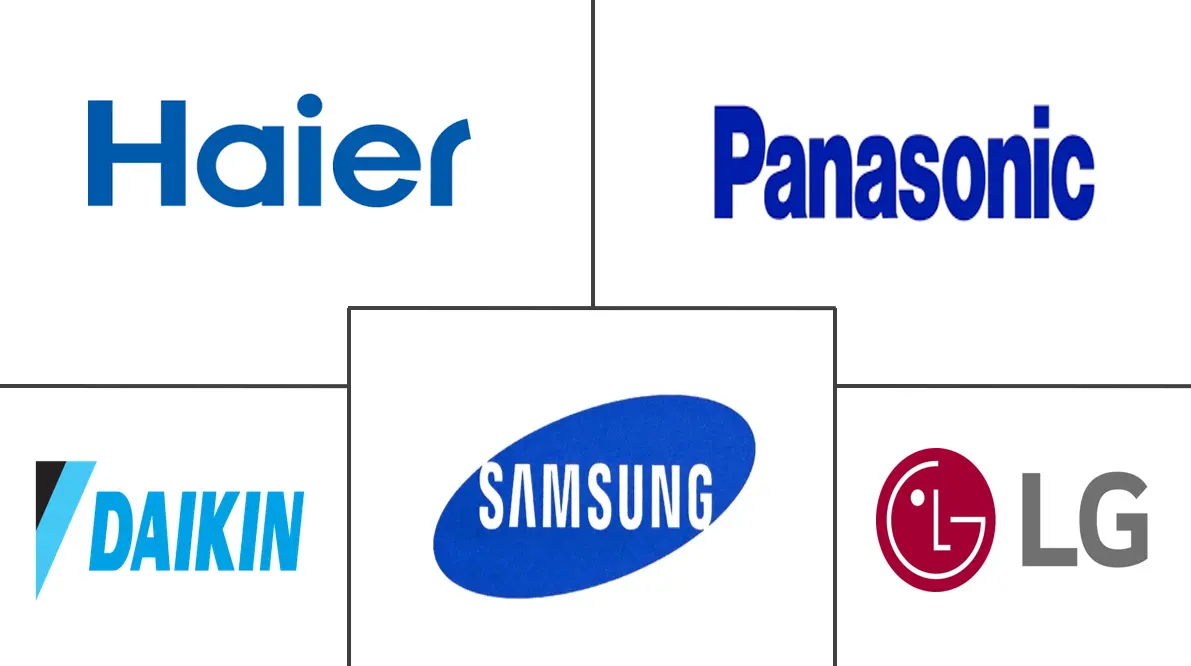
*Disclaimer: Major Players sorted in no particular order |
Air Conditioner Industry Analysis
The Global Air Conditioner Market size is estimated at USD 201.78 billion in 2024, and is expected to reach USD 259.49 billion by 2029, growing at a CAGR of 5.15% during the forecast period (2024-2029).
This industry analysis report indicates that the rising global temperatures and humidity levels and the growing recognition of air conditioners as a utility rather than luxury goods are predicted to drive significant growth in the air conditioning (AC) business. Driven by the introduction of sophisticated air conditioners, including models equipped with air purification systems and inverters, the AC market share is anticipating growth in the forecast period.
The worldwide supply chain and market demand including the market share of air conditioners were affected by the COVID-19 outbreak. China plays a significant role in the air conditioner market. Still, it also exports a variety of input supplies, which are needed to make finished items, to a wide range of nations. Due to the closure of their operations in China, other American and European air conditioning manufacturers have been forced to stop producing final goods temporarily. As a result, the market's imbalance between supply and demand widened.
The primary market growth factor driving the smart air conditioner market is the growing adoption of smart devices that can transform traditional remote-controlled air conditioners into smart devices. While packaged air conditioners are expected to expand at a moderate rate due to rising permit rates for the development of malls, offices, and industries, the demand for room air conditioners is being driven by improvements in housing standards.
Air Conditioner Market Trends
Growing Demand for Air Conditioners Globally
Market data confirms that the growing demand for air conditioners worldwide is propelled by a convergence of factors. Increasing global temperatures, attributed to climate change and urban heat island effects, are driving the need for air conditioning to maintain comfortable indoor environments, especially during hot summer months. Rapid urbanization, particularly in emerging economies, is leading to higher population densities in urban areas where heat retention is common, further increasing the demand for air conditioning in residential, commercial, and institutional buildings. The demand for air conditioning systems in both residential and commercial settings is being driven by the increased knowledge of the comfort and health benefits of air conditioning, including enhanced indoor air quality, humidity management, and relief from heat-related health conditions.
The market analysis indicates that the increasing demand for air conditioning in office buildings, retail spaces, healthcare facilities, data centers, and manufacturing plants is driving market growth as businesses prioritize employee comfort, productivity, and equipment cooling. Government initiatives that aim to improve energy efficiency and reduce greenhouse gas emissions are encouraging the adoption of energy-efficient air conditioning systems through regulations, incentives, and energy efficiency standards, thereby driving the global industry demand.
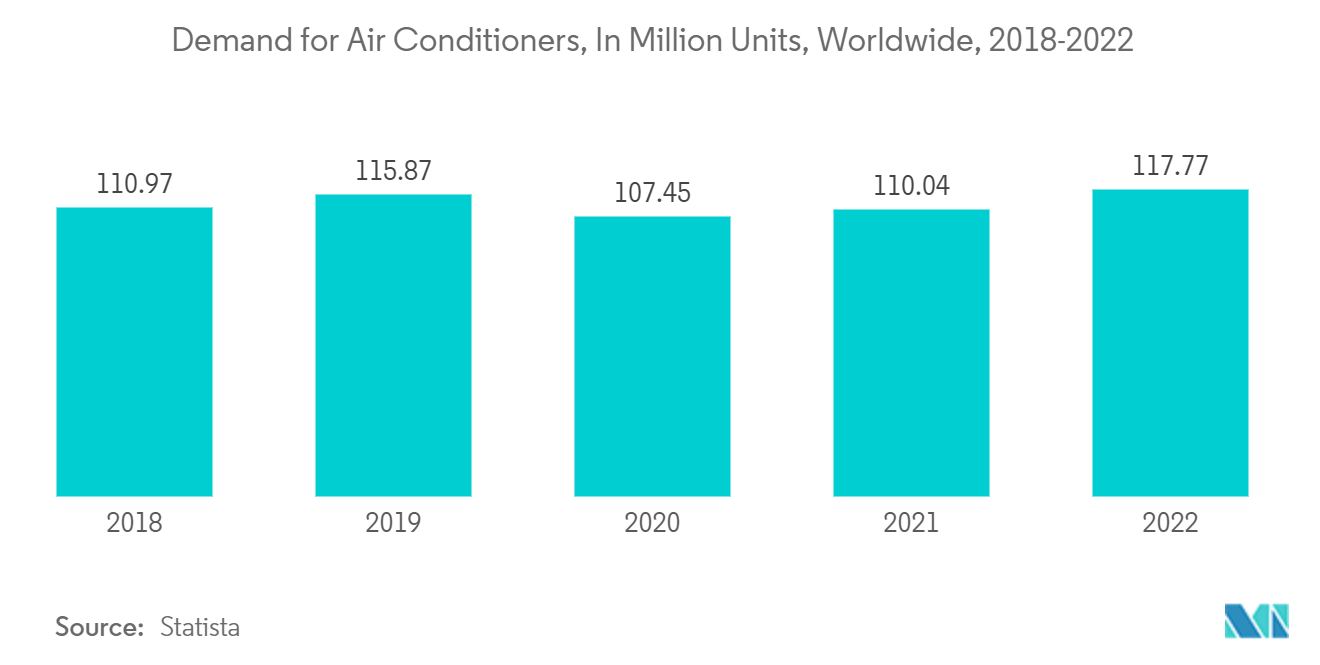
Asia-Pacific Dominating the Air Conditioner Market
Factors such as rapid urbanization, rise in temperatures, increase in disposable income, and increased demand for comfort solutions are driving Asia-Pacific to be one of the major markets worldwide. The region comprises some of the most densely populated countries, including China, India, Indonesia, and Japan, represents a significant target market for air conditioning systems. Increased population growth and urbanization in these countries have led to an increase in demand for air conditioning systems in the residential, business, and educational sectors. Rising temperatures, exacerbated by climate change, are driving the region's need for air conditioning solutions. Southeast and South Asian countries experience scorching and humid climates, leading to higher demand for air conditioning systems to provide comfortable cooling.
The market growth is driven by technological advances in air conditioning systems, such as inverter technology, intelligent and connected features, and energy-efficient designs. These advancements improve energy efficiency, reduce operating costs, and enhance user experience, leading to higher adoption rates. For example, companies like Daikin, Mitsubishi Electric, and Panasonic offer advanced air conditioning systems with inverter technology and smart features that appeal to consumers in Asia-Pacific. In order to encourage the adoption of energy-efficient models, a number of countries in Asia-Pacific have introduced Energy Efficiency Standards and Air Conditioning System Labelling Programmes. For example, the Indian government has introduced the Energy Conservation Building Code (ECBC) and the Bureau of Energy Efficiency (BEE) star rating program to promote energy-efficient air conditioning systems.
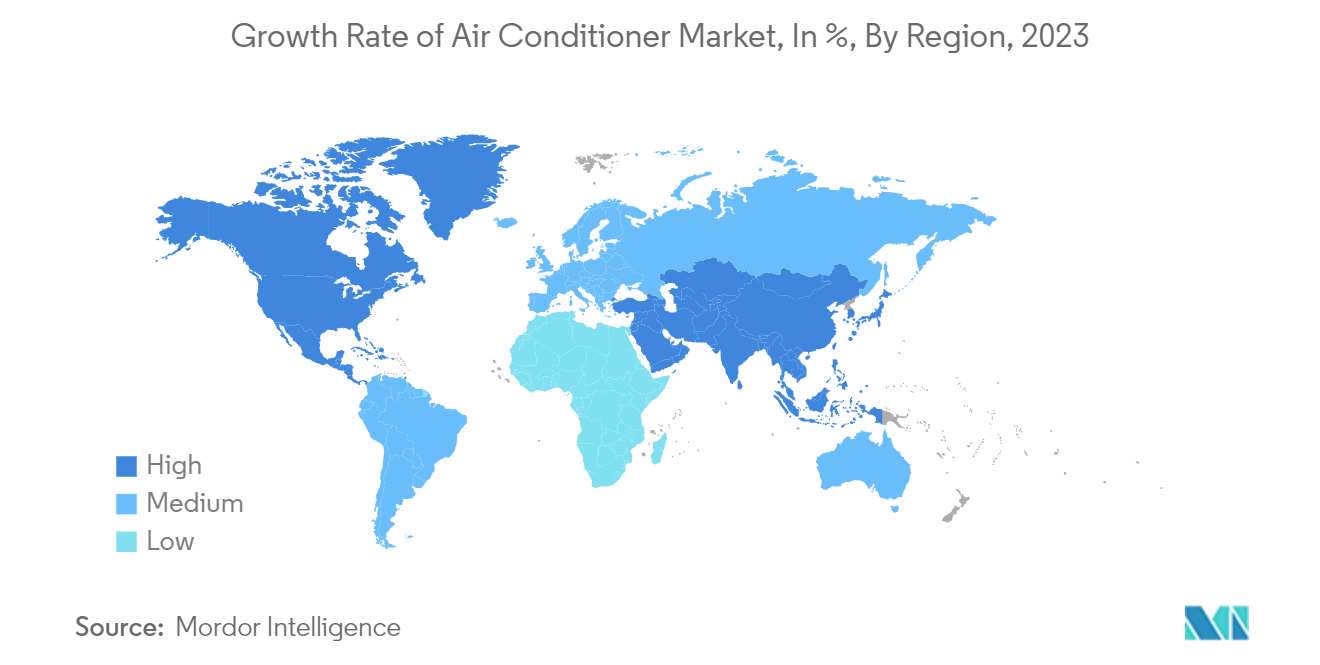
Air Conditioner Market Overview
The industry profile shows that the global market for air conditioners is highly competitive with many players competing around the world. The competitive landscape is characterized by both established multinational corporations and regional players, each striving to differentiate their products through innovation, energy efficiency, product features, and pricing strategies. The largest companies include Haier Group, Daikin Industries, LG Electronics, Samsung Electronics, and Panasonic Corporation.
Air Conditioner Market Leaders
-
Haier Group
-
Daikin Industries
-
LG Electronics
-
Samsung Electronics
-
Panasonic Corporation
- *Disclaimer: Major Players sorted in no particular order
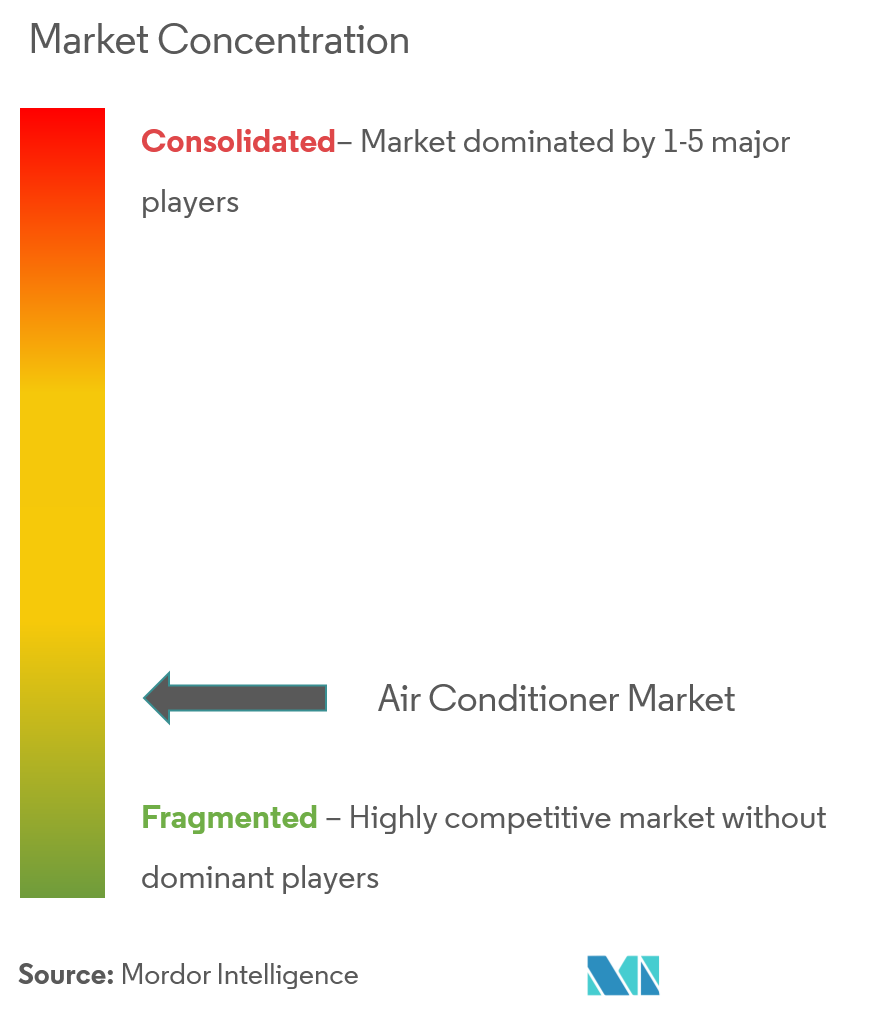
Air Conditioner Market News
- In February 2023, Godrej Appliances introduced the first leak-proof split air conditioner in India, exhibiting a creative use of anti-leak technology. This deliberate use of anti-leak technology highlights the business's dedication to improving user experience and creating an unmatched value offer in the air conditioning industry.
- In January 2022, LG Electronics USA launched a broad range of ventilation, heating, and air conditioning solutions for use in light commercial, residential, and industrial applications at the 2022 AHR show in Las Vegas.
Air Conditioner Industry Segmentation
An air conditioning unit is a device or system designed for the purpose of regulating temperature, humidity, and air quality in an open area, usually such as a room or building. It is capable of cooling the indoor air to a comfortable level by removing the heat from the air in the room and transferring it outside. As detailed in the report PDF, the air conditioner market is segmented by type, technology, end-user, distribution channel, and geography. By type, the market is segmented into window AC, split and multi-split AC, packaged air conditioners, variable refrigerant flow (VRF), central AC, and others (chillers and portables). By technology, the market is segmented into inverter and non-inverter. By end user, the market is segmented into residential and commercial. By distribution channel, the market is segmented into multi-brand stores, exclusive stores, and online stores. By geography, the market is segmented into North America, Latin America, Europe, Asia-Pacific, and Middle East and Africa, where price trend within each segment was analyzed to help businesses to adapt to changing market conditions. The market size and forecasts for the air conditioner market in value (USD) for all the above segments, including analysis of the target market, are offered in the report PDF
| By Type | Window AC | |
| Split and Multi-Split AC | ||
| Packaged AC | ||
| Variable Refrigerant Flow (VRF) | ||
| Central AC | ||
| Others | ||
| By Technology | Inverter | |
| Non-Inverter | ||
| By End-User | Residential | |
| Commercial | ||
| By Distribution Channel | Multi-Brand stores | |
| Exclusive Stores | ||
| Online Stores | ||
| By Geography | North America | United States |
| Canada | ||
| Mexico | ||
| Rest of North America | ||
| By Geography | Europe | United Kingdom |
| Germany | ||
| France | ||
| Russia | ||
| Italy | ||
| Spain | ||
| Rest of Europe | ||
| By Geography | Asia-Pacific | India |
| China | ||
| Japan | ||
| Australia | ||
| Rest of Asia-Pacific | ||
| By Geography | South America | Brazil |
| Argentina | ||
| Rest of South America | ||
| By Geography | Middle-East and Africa | United Arab Emirates |
| South Africa | ||
| Rest of Middle-East and Africa |
Air Conditioner (AC) Market Research FAQs
How big is the Global Air Conditioner Market?
The Global Air Conditioner Market size is expected to reach USD 201.78 billion in 2024 and grow at a CAGR of 5.15% to reach USD 259.49 billion by 2029.
What is the current Global Air Conditioner Market size?
In 2024, the Global Air Conditioner Market size is expected to reach USD 201.78 billion.
Who are the key players in Global Air Conditioner Market?
Haier Group, Daikin Industries, LG Electronics, Samsung Electronics and Panasonic Corporation are the major companies operating in the Global Air Conditioner Market.
Which is the fastest growing region in Global Air Conditioner Market?
North America is estimated to grow at the highest CAGR over the forecast period (2024-2029).
Which region has the biggest share in Global Air Conditioner Market?
In 2024, the Asia Pacific accounts for the largest market share in Global Air Conditioner Market.
What years does this Global Air Conditioner Market cover, and what was the market size in 2023?
In 2023, the Global Air Conditioner Market size was estimated at USD 191.39 billion. The report covers the Global Air Conditioner Market historical market size for years: 2020, 2021, 2022 and 2023. The report also forecasts the Global Air Conditioner Market size for years: 2024, 2025, 2026, 2027, 2028 and 2029.
What are the different segments of the Air Conditioner Market?
The Air Conditioner Market is segmented by a) Product Type: Window, Split and Multi Split, Packaged Air Conditioner, Variable Refrigerant Flow (VRF) b) Distribution Channel: Multi-Brand Stores, Exclusive Stores, Online, And Other Distribution Channels c) End User: Residential and Commercial
Our Best Selling Reports
Air Conditioner Industry Report
The global air conditioning systems market is witnessing robust growth, propelled by technological advancements, changing climate patterns, and increasing consumer demand for comfort in the AC industry. This surge is primarily due to rising temperatures from climate change, positioning air conditioning from a luxury to a necessity in residential and commercial spaces. The shift towards energy-efficient and environmentally friendly solutions, emphasizing inverter technology and smart connectivity, is enhancing user experience and operational efficiency. Dominated by Asia-Pacific, particularly China and India, due to rapid urbanization and economic development, the air conditioner market also sees significant contributions from North America and Europe, spurred by replacement sales and energy efficiency initiatives. This highly competitive market sees air conditioning companies focusing on technological innovations and strategic partnerships to cater to evolving consumer needs. For detailed market share, size, and industry revenue growth rate, Mordor Intelligence™ Industry Reports offer a comprehensive industry analysis, market forecast outlook, and industry statistics available as a free report PDF download for a deeper insight into the air conditioner analysis. For a comprehensive analysis of the air conditioner market trend, overall market cap, sales data, market segmentation and the target market, stakeholders can access detailed reports available in profile PDF format, providing in-depth insights and analysis.




